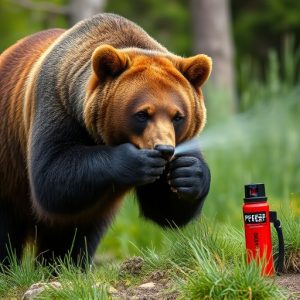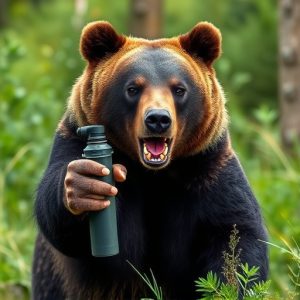Navigating Alaska’s Bear Spray Laws: Use, Safety, and Environmental Considerations
Understanding bear spray fog patterns is key for navigating Alaska's wilderness safely, with re…….
Understanding bear spray fog patterns is key for navigating Alaska's wilderness safely, with regulations strictly governing its use to balance human safety and wildlife conservation. Bear spray is prohibited in ecologically sensitive areas like national parks and preserves to protect biodiversity. Proper usage techniques focusing on the bear's face are crucial, while avoiding urban or water-adjacent areas prevents harm to humans and bears. Following local regulations, including understanding where bear spray is prohibited, is vital for preserving unique ecosystems and wildlife habitats.
Alaska’s vast wilderness makes bear encounters a real possibility, especially with proper preparation. Understanding bear spray fog patterns is crucial for your safety while exploring the state. This guide covers everything from legal considerations and application techniques to environmental impacts and product choices. Learn where bear spray use is prohibited in Alaska and discover how to select the right protection for you and the environment.
- Understanding Bear Spray Fog Patterns: What You Need to Know
- Legal Considerations: Where Is Bear Spray Use Prohibited in Alaska?
- Safety First: Effective Application Techniques for Maximum Protection
- Environmental Impact: The Role of Bear Spray in Conservation Efforts
- Choosing the Right Bear Spray: Key Factors for Alaskans and Visitors
Understanding Bear Spray Fog Patterns: What You Need to Know
Understanding bear spray fog patterns is crucial when venturing into Alaska’s wilderness. Unlike direct sprays, which are aimed at specific targets, fog patterns create a protective cloud that can cover a wide area. This method is particularly effective in dense forests or areas with strong winds where direct application might be challenging. The fog pattern allows for a more even distribution of the spray, ensuring maximum coverage against bears.
Knowing where bear spray is prohibited is also essential. In some areas, use of bear spray may be restricted due to environmental concerns or unique ecosystems. Always check with local authorities or park rangers before carrying and using bear spray. They can provide insights into safe usage practices and specific regulations related to where and how it can be employed to deter potential bear encounters without causing harm to the local environment.
Legal Considerations: Where Is Bear Spray Use Prohibited in Alaska?
In Alaska, the use of bear spray is governed by strict regulations aimed at preserving both human safety and wildlife habitats. While it’s a common tool for outdoor enthusiasts and residents to protect themselves against bears, there are specific areas where its use is prohibited. State laws and local ordinances dictate these restrictions, often focusing on sensitive ecosystems and areas with high biodiversity. For instance, bear spray use might be banned in national parks, wilderness preserves, and certain rural communities to avoid disturbing wildlife or causing ecological damage.
Understanding these legal boundaries is crucial for anyone considering carrying bear spray in Alaska. Visitors and residents alike must familiarize themselves with the specific regulations of the regions they plan to visit. Failure to comply with these restrictions can result in fines or other penalties. Remember, knowing where bear spray use is prohibited helps ensure a safe and responsible experience in Alaska’s diverse outdoor environment.
Safety First: Effective Application Techniques for Maximum Protection
When it comes to bear spray, safety should always be the top priority. Understanding how and where to apply it effectively is crucial for maximum protection against potential bear encounters in Alaska. One common mistake people make is not using their bear spray properly, which can lead to reduced effectiveness or even no protection at all.
In areas where bear spray is permitted, it’s vital to familiarize yourself with the recommended application techniques. This includes aiming for the face and eyes of the bear, as this is when the spray is most effective in causing a distraction or even temporary blindness. Remember, bear spray is not a foolproof defense; its effectiveness depends on proper usage and understanding where it’s prohibited, such as in urban settings or near water sources, to avoid unnecessary harm to both humans and bears.
Environmental Impact: The Role of Bear Spray in Conservation Efforts
Bear spray, also known as bear deterrent or bear repellent, has become a crucial tool in conservation efforts for several reasons, especially regarding human-wildlife interaction. When used properly, it can significantly reduce conflicts between humans and bears, which is essential in areas where grizzlies and black bears inhabit. In regions like Alaska, where bear encounters are common, the strategic deployment of bear spray helps both residents and visitors navigate these wild landscapes safely.
However, it’s important to note that bear spray isn’t without environmental considerations. Its usage must adhere to strict regulations, especially regarding application methods and prohibited areas. For instance, many national parks and wildlife reserves in Alaska have specific guidelines on where and how bear spray can be used to ensure the preservation of natural habitats and minimize ecological impact. Understanding these rules is vital, as using bear spray inappropriately could potentially harm non-target species and disrupt sensitive ecosystems, underscoring the importance of following local regulations, especially when it comes to protecting Alaska’s unique wilderness and its inhabitants.
Choosing the Right Bear Spray: Key Factors for Alaskans and Visitors
When selecting bear spray, Alaskans and visitors should consider several key factors to ensure its effectiveness in potentially dangerous encounters. First, understand that not all areas allow the use of bear spray. It’s crucial to check local regulations, as certain regions within Alaska have restrictions on where and when bear spray can be used, especially in close proximity to parks, wilderness areas, and wildlife refuges. These bans are often in place to protect both wild animals and human visitors.
Additionally, the type of spray, its concentration, and range vary among brands. Look for a product with a proven track record of success, typically indicated by certifications from reputable organizations. Consider the distance at which you’ll be able to effectively deploy the spray—some bear sprays offer longer-range options, which can be beneficial in unpredictable scenarios.
In conclusion, understanding bear spray fog patterns, legal considerations regarding its use, effective application techniques, environmental impact, and choosing the right product are paramount for safety in Alaska’s diverse landscapes. Remember that while bear spray is a valuable tool, it’s crucial to know where its use is prohibited and always prioritize safety when encountering bears.


